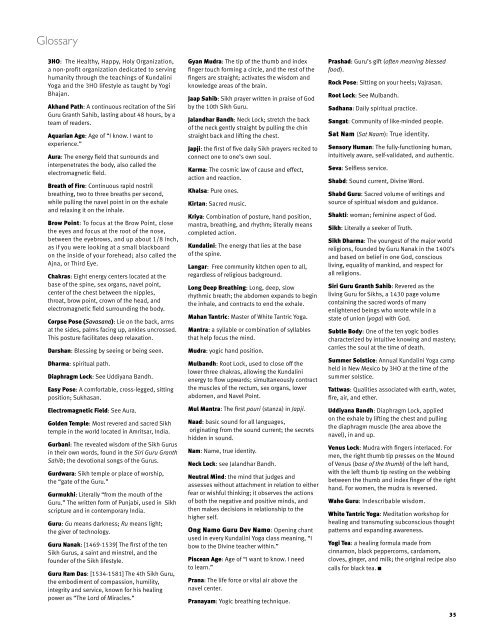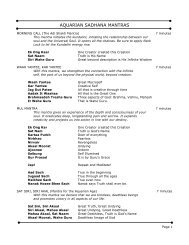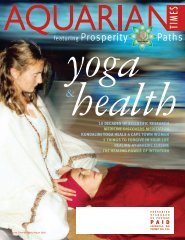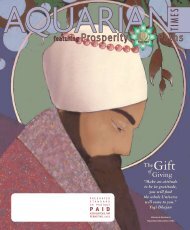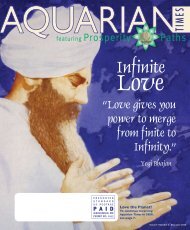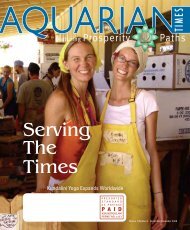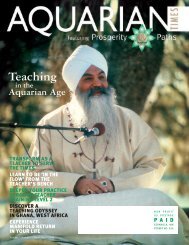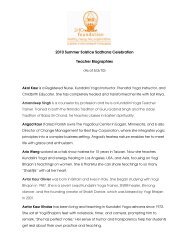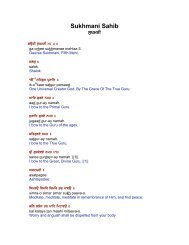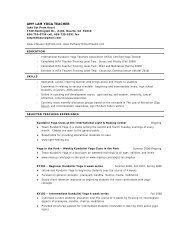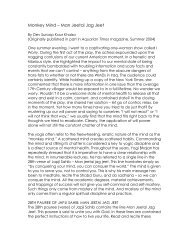Spirit - 3HO
Spirit - 3HO
Spirit - 3HO
You also want an ePaper? Increase the reach of your titles
YUMPU automatically turns print PDFs into web optimized ePapers that Google loves.
Glossary<br />
<strong>3HO</strong>: The Healthy, Happy, Holy Organization,<br />
a non-profit organization dedicated to serving<br />
humanity through the teachings of Kundalini<br />
Yoga and the <strong>3HO</strong> lifestyle as taught by Yogi<br />
Bhajan.<br />
Akhand Path: A continuous recitation of the Siri<br />
Guru Granth Sahib, lasting about 48 hours, by a<br />
team of readers.<br />
Aquarian Age: Age of “I know. I want to<br />
experience.”<br />
Aura: The energy field that surrounds and<br />
interpenetrates the body, also called the<br />
electromagnetic field.<br />
Breath of Fire: Continuous rapid nostril<br />
breathing, two to three breaths per second,<br />
while pulling the navel point in on the exhale<br />
and relaxing it on the inhale.<br />
Brow Point: To focus at the Brow Point, close<br />
the eyes and focus at the root of the nose,<br />
between the eyebrows, and up about 1/8 inch,<br />
as if you were looking at a small blackboard<br />
on the inside of your forehead; also called the<br />
Ajna, or Third Eye.<br />
Chakras: Eight energy centers located at the<br />
base of the spine, sex organs, navel point,<br />
center of the chest between the nipples,<br />
throat, brow point, crown of the head, and<br />
electromagnetic field surrounding the body.<br />
Corpse Pose (Savasana): Lie on the back, arms<br />
at the sides, palms facing up, ankles uncrossed.<br />
This posture facilitates deep relaxation.<br />
Darshan: Blessing by seeing or being seen.<br />
Dharma: spiritual path.<br />
Diaphragm Lock: See Uddiyana Bandh.<br />
Easy Pose: A comfortable, cross-legged, sitting<br />
position; Sukhasan.<br />
Electromagnetic Field: See Aura.<br />
Golden Temple: Most revered and sacred Sikh<br />
temple in the world located in Amritsar, India.<br />
Gurbani: The revealed wisdom of the Sikh Gurus<br />
in their own words, found in the Siri Guru Granth<br />
Sahib; the devotional songs of the Gurus.<br />
Gurdwara: Sikh temple or place of worship,<br />
the “gate of the Guru.”<br />
Gurmukhi: Literally “from the mouth of the<br />
Guru.” The written form of Punjabi, used in Sikh<br />
scripture and in contemporary India.<br />
Guru: Gu means darkness; Ru means light;<br />
the giver of technology.<br />
Guru Nanak: [1469-1539] The first of the ten<br />
Sikh Gurus, a saint and minstrel, and the<br />
founder of the Sikh lifestyle.<br />
Guru Ram Das: [1534-1581] The 4th Sikh Guru,<br />
the embodiment of compassion, humility,<br />
integrity and service, known for his healing<br />
power as “The Lord of Miracles.”<br />
Gyan Mudra: The tip of the thumb and index<br />
finger touch forming a circle, and the rest of the<br />
fingers are straight; activates the wisdom and<br />
knowledge areas of the brain.<br />
Jaap Sahib: Sikh prayer written in praise of God<br />
by the 10th Sikh Guru.<br />
Jalandhar Bandh: Neck Lock; stretch the back<br />
of the neck gently straight by pulling the chin<br />
straight back and lifting the chest.<br />
Japji: the first of five daily Sikh prayers recited to<br />
connect one to one’s own soul.<br />
Karma: The cosmic law of cause and effect,<br />
action and reaction.<br />
Khalsa: Pure ones.<br />
Kirtan: Sacred music.<br />
Kriya: Combination of posture, hand position,<br />
mantra, breathing, and rhythm; literally means<br />
completed action.<br />
Kundalini: The energy that lies at the base<br />
of the spine.<br />
Langar: Free community kitchen open to all,<br />
regardless of religious background.<br />
Long Deep Breathing: Long, deep, slow<br />
rhythmic breath; the abdomen expands to begin<br />
the inhale, and contracts to end the exhale.<br />
Mahan Tantric: Master of White Tantric Yoga.<br />
Mantra: a syllable or combination of syllables<br />
that help focus the mind.<br />
Mudra: yogic hand position.<br />
Mulbandh: Root Lock, used to close off the<br />
lower three chakras, allowing the Kundalini<br />
energy to flow upwards; simultaneously contract<br />
the muscles of the rectum, sex organs, lower<br />
abdomen, and Navel Point.<br />
Mul Mantra: The first pauri (stanza) in Japji.<br />
Naad: basic sound for all languages,<br />
originating from the sound current; the secrets<br />
hidden in sound.<br />
Nam: Name, true identity.<br />
Neck Lock: see Jalandhar Bandh.<br />
Neutral Mind: the mind that judges and<br />
assesses without attachment in relation to either<br />
fear or wishful thinking; it observes the actions<br />
of both the negative and positive minds, and<br />
then makes decisions in relationship to the<br />
higher self.<br />
Ong Namo Guru Dev Namo: Opening chant<br />
used in every Kundalini Yoga class meaning, “I<br />
bow to the Divine teacher within.”<br />
Piscean Age: Age of “I want to know. I need<br />
to learn.”<br />
Prana: The life force or vital air above the<br />
navel center.<br />
Pranayam: Yogic breathing technique.<br />
Prashad: Guru’s gift (often meaning blessed<br />
food).<br />
Rock Pose: Sitting on your heels; Vajrasan.<br />
Root Lock: See Mulbandh.<br />
Sadhana: Daily spiritual practice.<br />
Sangat: Community of like-minded people.<br />
Sat Nam (Sat Naam): True identity.<br />
Sensory Human: The fully-functioning human,<br />
intuitively aware, self-validated, and authentic.<br />
Seva: Selfless service.<br />
Shabd: Sound current, Divine Word.<br />
Shabd Guru: Sacred volume of writings and<br />
source of spiritual wisdom and guidance.<br />
Shakti: woman; feminine aspect of God.<br />
Sikh: Literally a seeker of Truth.<br />
Sikh Dharma: The youngest of the major world<br />
religions, founded by Guru Nanak in the 1400’s<br />
and based on belief in one God, conscious<br />
living, equality of mankind, and respect for<br />
all religions.<br />
Siri Guru Granth Sahib: Revered as the<br />
living Guru for Sikhs, a 1430 page volume<br />
containing the sacred words of many<br />
enlightened beings who wrote while in a<br />
state of union (yoga) with God.<br />
Subtle Body: One of the ten yogic bodies<br />
characterized by intuitive knowing and mastery;<br />
carries the soul at the time of death.<br />
Summer Solstice: Annual Kundalini Yoga camp<br />
held in New Mexico by <strong>3HO</strong> at the time of the<br />
summer solstice.<br />
Tattwas: Qualities associated with earth, water,<br />
fire, air, and ether.<br />
Uddiyana Bandh: Diaphragm Lock, applied<br />
on the exhale by lifting the chest and pulling<br />
the diaphragm muscle (the area above the<br />
navel), in and up.<br />
Venus Lock: Mudra with fingers interlaced. For<br />
men, the right thumb tip presses on the Mound<br />
of Venus (base of the thumb) of the left hand,<br />
with the left thumb tip resting on the webbing<br />
between the thumb and index finger of the right<br />
hand. For women, the mudra is reversed.<br />
Wahe Guru: Indescribable wisdom.<br />
White Tantric Yoga: Meditation workshop for<br />
healing and transmuting subconscious thought<br />
patterns and expanding awareness.<br />
Yogi Tea: a healing formula made from<br />
cinnamon, black peppercorns, cardamom,<br />
cloves, ginger, and milk; the original recipe also<br />
calls for black tea. +<br />
3


